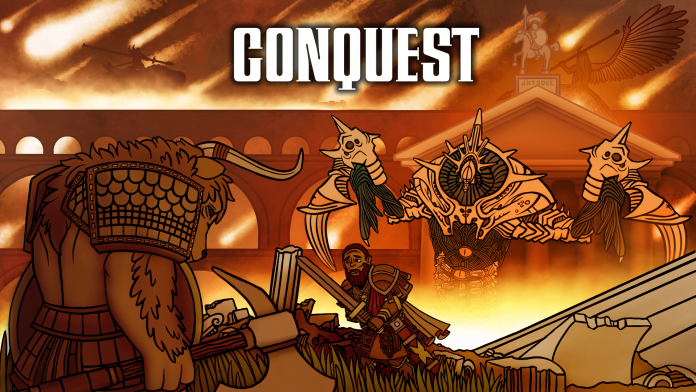Welcome back to my mini-series on the smaller skirmish form of Conquest: First Blood. This article is aimed at people who have already played The Last Argument of Kings (TLAOK) and want to dip their toe in First Blood (FB) as well as people who are just learning or interested in learning this game. Today we will be looking at the basics of First Blood Not the strategy behind it, not the way each army is played – but how do you even play FB? We will take a look at the key major difference between FB and TLAOK, how do you start a game of FB? What are the turn sequences? All of this and more in this introductory article to FB!
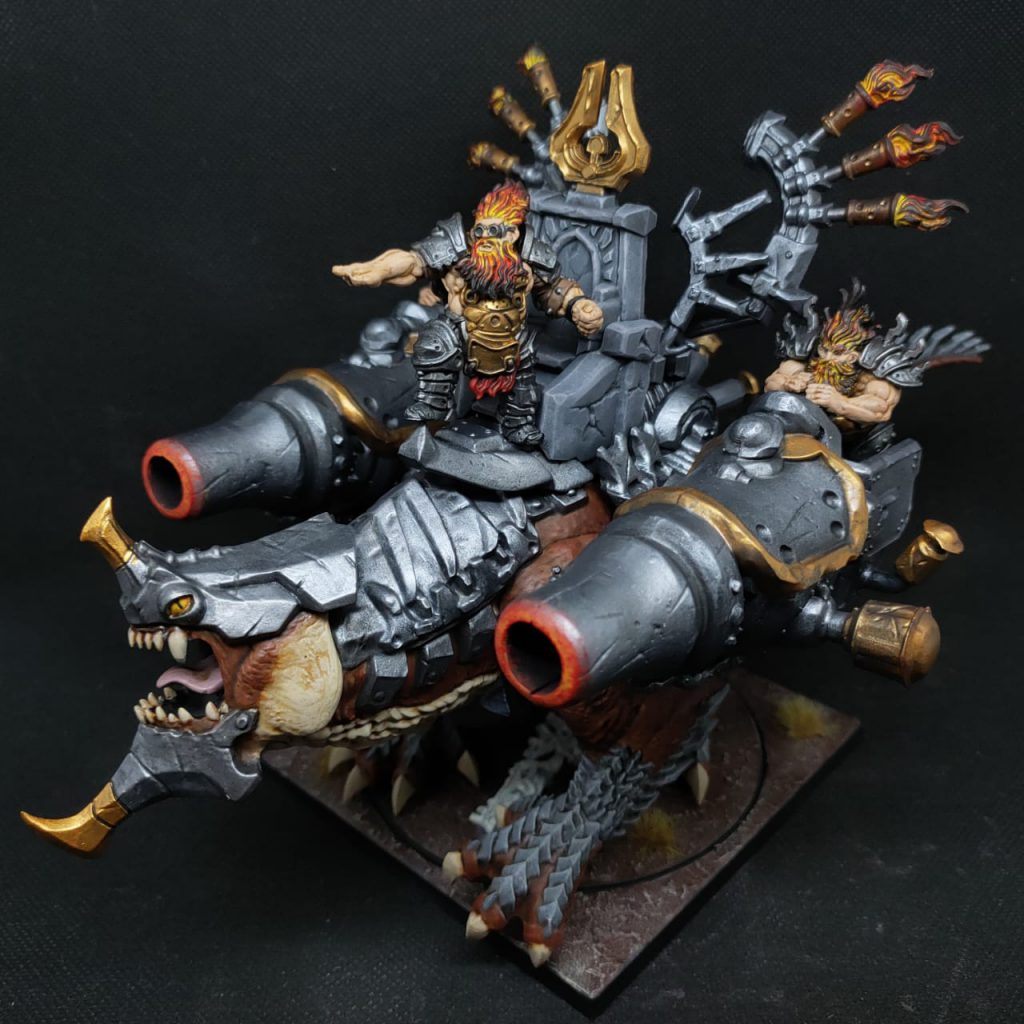
What Is First Blood?
First Blood is a skirmish version of the rank and flank game Conquest: The Last Argument of Kings. Made by the same company, using the same models and roughly have the same look and feel of the unit themselves. The basic rules are similar, the stat block is similar, and the units in First Blood do roughly the same thing as their TLAOK brethren.
While skirmish might be a slight misnomer considering the amount of models in each warband is – they could range from a handful if you are using monsters and cavalries. To a few dozens if you are fielding an army of infantries. A First Blood game is played between 20-40 models depending on what army you are playing.
The game is played on a 4 x 4 table with each player recommended to bring close to 1,000 points worth of units. Of course you can play in any size of game you want, but 1,000 is the tournament standard. There is a recommendation to place two terrain pieces on each ‘quadrant,’ making 8 terrain pieces the standard setup for most FB table.
The uniqueness of First Blood is that it is played in a ‘programming’ style of activation – where you pre-plan the activation order at the start of the round. Each player then takes turn activating one unit until there are no more units.
Key Differences Between TLAOK and FB
| Component | TLAOK | FB |
| Table Size | 6 x 4 | 4 x 4 |
| Points Size | 2,000 | 1,000 |
| Base | Square tray base | Circle base |
| Supremacy | Once per game or passive | No supremacy |
| Character | Multiple characters | Only one character |
| Army building restriction | Mainstay and restricted | None |
| Deployment | Roll each turn to see who arrives | All units are deployed at the start |
Building a First Blood Army
Right off the bat, we are hit with the key difference between TLAOK and FB: Instead of having characters with ‘mainstay’ and ‘restricted’ we can bring any type of unit into our list. The main restrictions that apply are that you can only bring up to three brute or cavalry in one unit, and 12 infantry models in the same unit.
Additionally, you can only bring one named character in your army. The characters in FB are generally more powerful than any other units in the game and offer a plethora of abilities to your units. Namely, the ability to hand out commands – a unique ability characters have to give a buff or debuff to another unit.
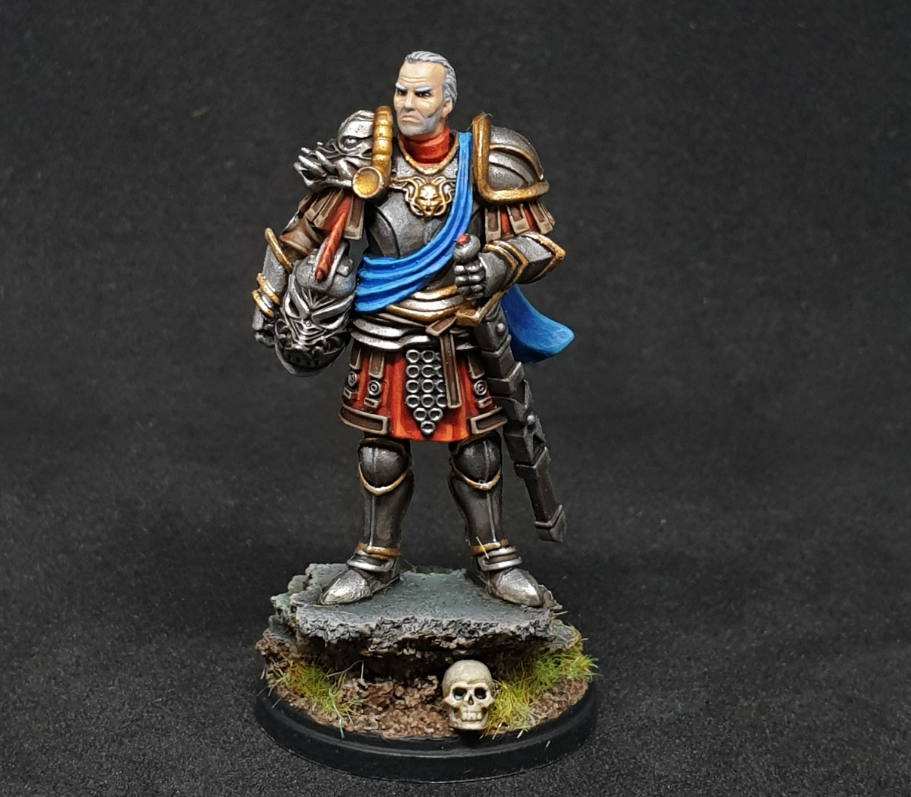
The Phases
Reinforcement Phase
In FB, each army is deployed at the start of the game. Starting with the player who won the deployment roll, each player alternates deploying a unit from their army until every unit has been placed on the table. There are some special abilities that can enable units to come in at a later turn; this phase will be where those abilities resolve.
Depending on the scenario, the deployment zone can differ in size. But typically your army will be deployed around the 8-12” mark from your side of the table.
Command Phase
This phase is the same as TLAOK, where each player will take each of your command cards and then create what is called a command stack. Each player depending on initiative turn will flip open the first card of the command stack and then resolve the unit’s activation.
Supremacy Phase
Huh, where’s the supremacy ability? That’s right, instead of having a unique once per game ability (or a passive buff to your army) FB bakes those abilities into each of the characters themselves.
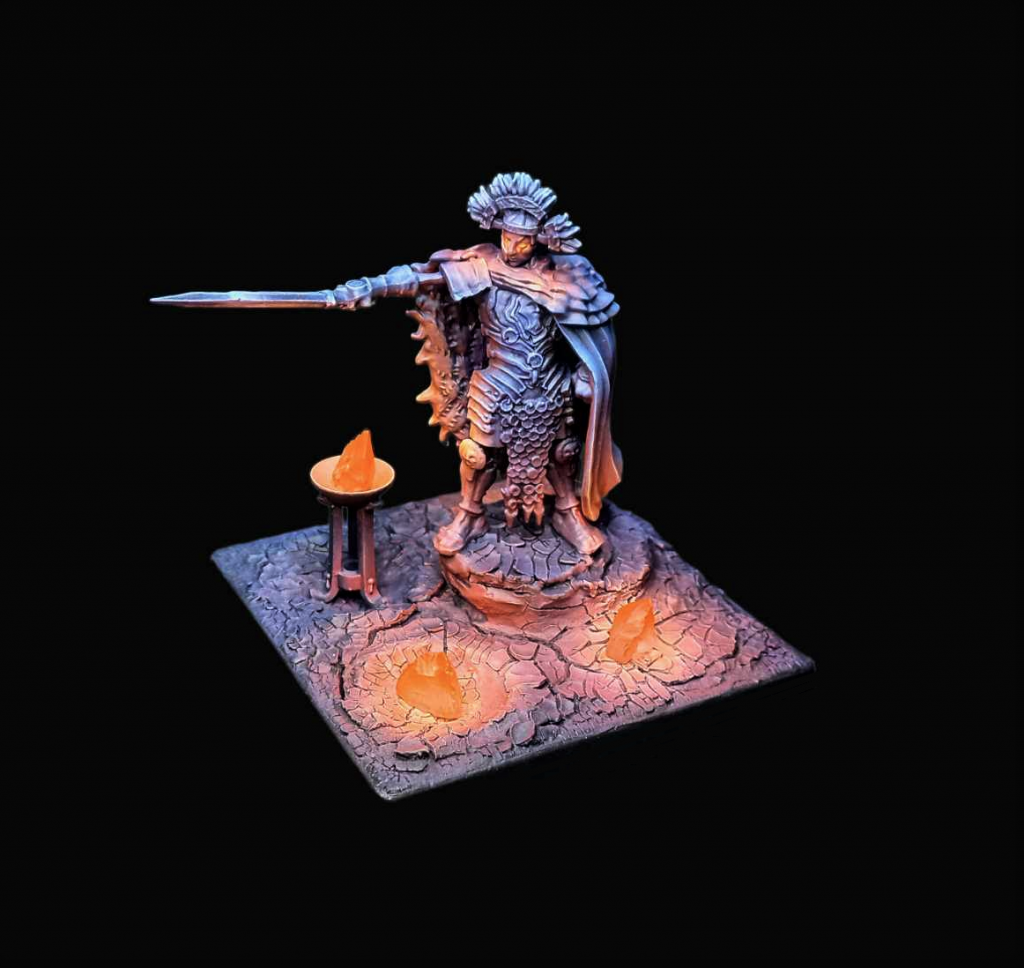
Action Phase
This is where the fun begins. Each unit in FB starts with two actions to use as they please, with the caveat that they cannot repeat those actions (except for march). So that means you can march-charge, or you can inspire-clash, and in a rare situation, you could even clash then volley. But before all of this, let’s learn to read the stats block of a unit shall we?
The Anatomy of a Unit in FB

Let’s take the humble men-at-arm as an example here.
On the top right are the cost to a men-at-arms unit, 90 points. FB is recommended for play at 1,000 points and Parabellum has a free army builder app and in their website to try out build. The number below them are the amount of models that comes with that 90 points – for Men-at-Arms, it’s 4. This is a minimum sized for infantry units.
Underneath the name we have the unit’s types, here Infantry and Medium. The type infantry means that it has the seizing power of an infantry (explained later in scoring) and that means this unit will be affected by any rules or abilities that triggers off ‘infantry.’ Medium is also a sub-type, which might matter in a certain scenario.
As for the stats themselves, starting from the left we have M. M stands for Movement in inches. This is how far a unit can move and also how far they can charge. The second march action for the turn uses half the unit’s M stat instead of the full value.
V stands for Volley. This represents how accurate those units are in ranged combat. As men-at-arms do not have any ranged capabilities, their V stat is a low 1, meaning that you will only hit on a roll of 1. Ranged units typically have a higher volley stats than this.
C stands for Clash. This represents how accurate those units are in melee combat. Clash of 2 means that they hit on a roll of 1 and 2. Again, not looking great for your men-at-arms here. A melee specialist will have a clash of around 3 or 4.
A stands for Attack. The value of this number denotes how many attacks are generated per model. For units, this means that this number will be multiplied by the amount of model you have. ‘Standard’ infantry will usually have 1 attack per model. ‘Elite’ infantry can have 2 attacks per model. Cavalry and brute are different, ranging from 5 to 8 attacks per model.
W stands for Wounds. This value represents how much damage your unit can take before being destroyed. Infantry start with 2 wounds, while brutes and cavalries can range between 5 to 7 wounds per model and monsters can have up to twenty.
R stands for Resolve. This value represents how courageous and steadfast your units are when encountering situations that would break people in combat. A low unit resolve means that they will flee combat in the first signs of danger while a higher value means that they are far more disciplined and hardened.
D stands for Defense. Defense can be flavored a couple different ways; it can be the suit of armor the unit is wearing, or how thick of a carapace it has covering its squishy insides. Defense saves are rolled when your units gets hit in combat. Any failed defense rolls will deduct from the wound count.
E stands for Evasion. Also known as ‘ward saves’ or ‘invulnerable saves’ in a typical Warhammer lingo. This stats represents how agile the unit is at evading attacks altogether. That mighty swing from a giant axe that would typically cleave through your armor can be evaded altogether with a well-timed step to the left. When your unit is taking a defense roll, you can either use the unit’s defense stat or evasion stat. You cannot use them one after the other.
CR stands for Command Range. This special stats only exists for character or certain officers. This represents the ability of your characters to issue command to another unit. Most commands requires you to be within command range of the character or some abilities will check whether you are in command range of a certain model.
Below comes the plethora of special rules and abilities; each of them can be clicked through for more information. Let’s take shield as an example:
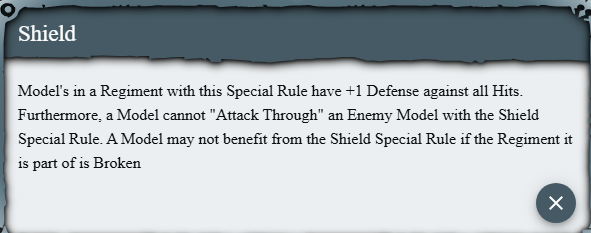
Underneath the special rules and abilities we have what is known as command models. Typically for infantry, they come in with a leader model. There are no special models that can be assigned as a leader, so you need to clearly identify who is the leader. It’s typically the model with the pointiest hat or, in the example below, the one with the longest spear.
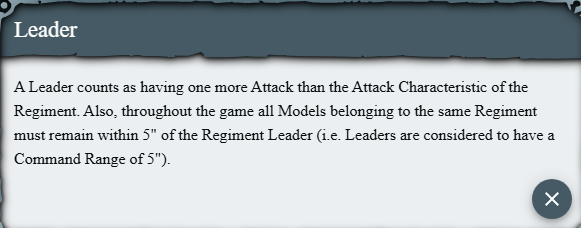
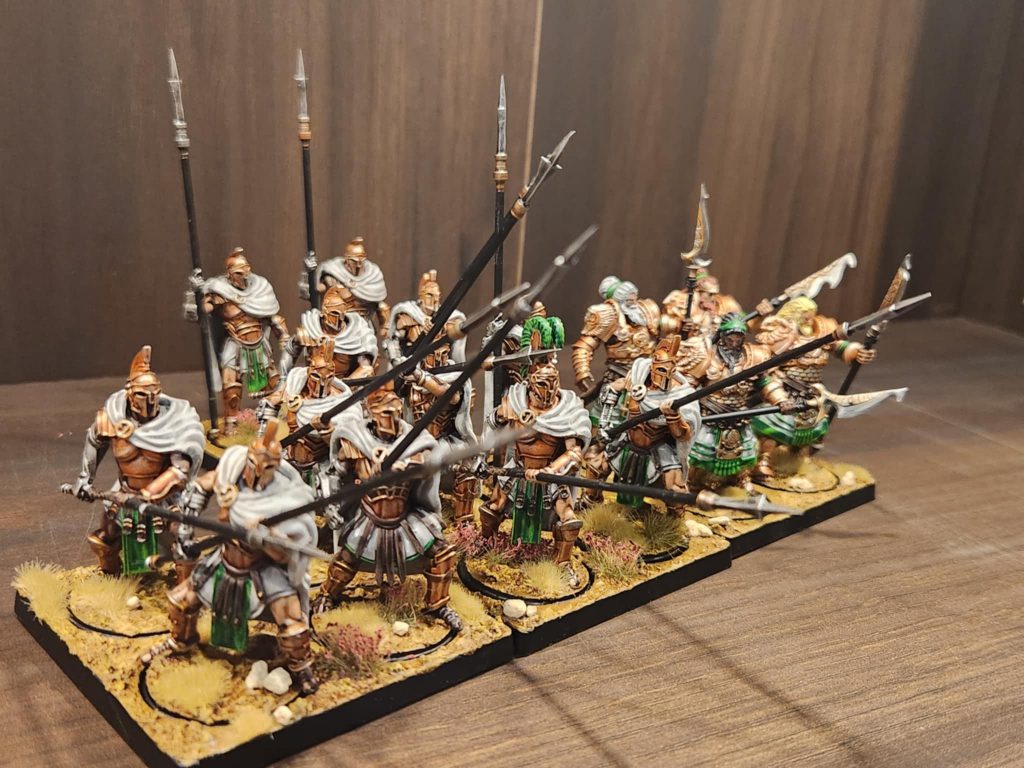
Now that you are more acquainted with the stats, let’s get to the gameplay.
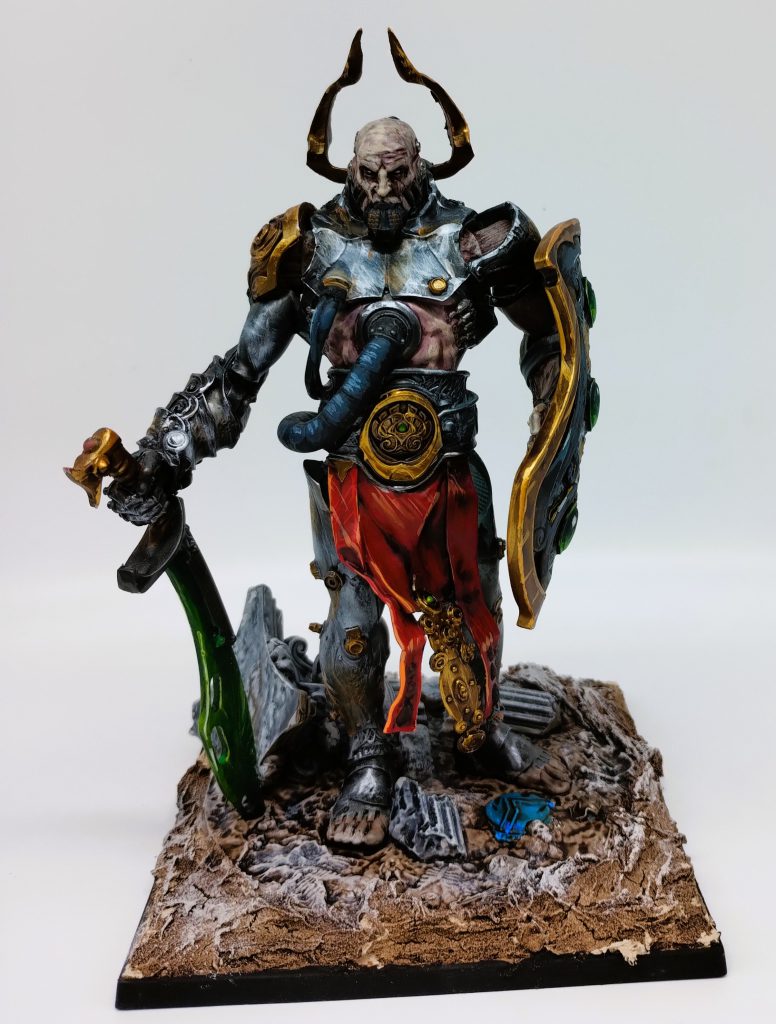
The Action Phase
Movement / March
FB is played using the circle base instead of the square tray that TLAOK has. This makes movement more fluid but it requires a different approach from the rank and flank style of the larger game. Instead of moving a tray, each model is moved individually.
You take a single model and then measure their movement in inches. That model resolves their movement and then you do the same thing for each model in your unit. There is a coherency of 6” between each of your models, but typically you would bunch up your models together to make it easier.
March action is the only thing that a unit can do twice each round. The second march action of each unit is done at half the unit’s movement value.
Charge
Simple: You take a model and measure the distance between them and the target unit in inches. If you are in range, then you can charge. There is no dice roll to modify the distance of the charge. FB uses a fixed distance charge similar to a few other game systems like Saga. This removes randomness in the movement and promotes a more tactical playstyle.
Once the first model contacts the opposing model, the rest of the unit soon follows. After a charge move, you get a 2” ‘consolidation’ move where you can move closer to the enemy unit. Keep in mind that in FB there is this concept of engagement range: A bubble of 0.5” extends around each of your models, and any unit that enters that bubble is considered engaged with your unit. Some models have special rules or abilities that can modify these engagement range.
Something to also note is that the charge action only allows you to engage with the enemy. You do not get to perform a free clash action after you charge, but you will get a bonus +1 to hit. The only attack you can perform after charge are impact hits. Impact hits comes naturally for brute, cavalry and monster and some very rare infantry.
Clash
This is where you kill the enemy in glorious combat! You can only clash against enemies within the engagement range. Some models with spears or long arms have special rules that can modify this engagement range. Important rules or abilities will be checked using this engagement range. And most importantly, you cannot volley into something that is engaged. More on that later.
You take your C stat and then you roll as many dice as your units have in your A stat. This A stats represents a single model, so if you have 8 infantry models with 1 A, that means you have 8 attacks. First Blood differs from TLOAK in that a low roll is good. So if you are like me and rolls plenty of 1s instead of 6s – this game is excellent for you!
Volley
Ranged attack, basically. The unit uses their bows, crossbows, slings, balls of corrosive hits – what have you to hit the enemy from afar. You take barrage profile of the unit, for example:
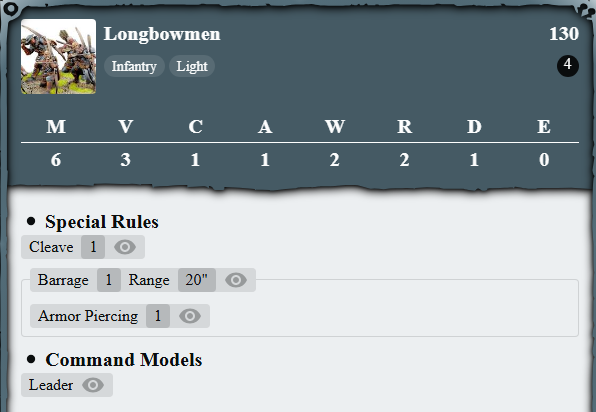
This means that this particular unit has 1 ranged attack each at 20” range. They have a volley of 3 which means that any dice of 3 and lower is a hit.

Defense Rolls and Wound Rolls
These are largely similar to TLAOK in the sense that each clash or volley (or other action that generates a defense roll such as dueling or offensive spellcasting) will trigger a defense roll. Check how many hits are generated by the action and then roll the same amount of dice against your Defense stats. Any rolls that are above that defense stat will be translated to wounds.
You’re not done yet. Any wounds that are taken will then have to be saved against your Resolve stats. These are called resolve tests. There are modifiers that improve your resolve stats, such as having a large block of units or by hanging out near your character (which typically is braver than any random soldiers).
Wounds are taken out from the models that are engaged first, with priority given to models that have already received a wound. While this can create a scenario where the fight is cluttered because you have to take out models from the middle of the melee, but the purpose of this is so that they can ‘clear’ up shooting lanes.
Finally, each model destroyed in FB generates casualty tokens. These are markers that tells you how many models were removed from play last round and which vanish at the start of the next round. Casualty tokens are a key component of the game because they limit how much healing you can do in a round; some special rules or abilities also rely on this mechanic.
Let’s give an example to illustrate the above scenario:
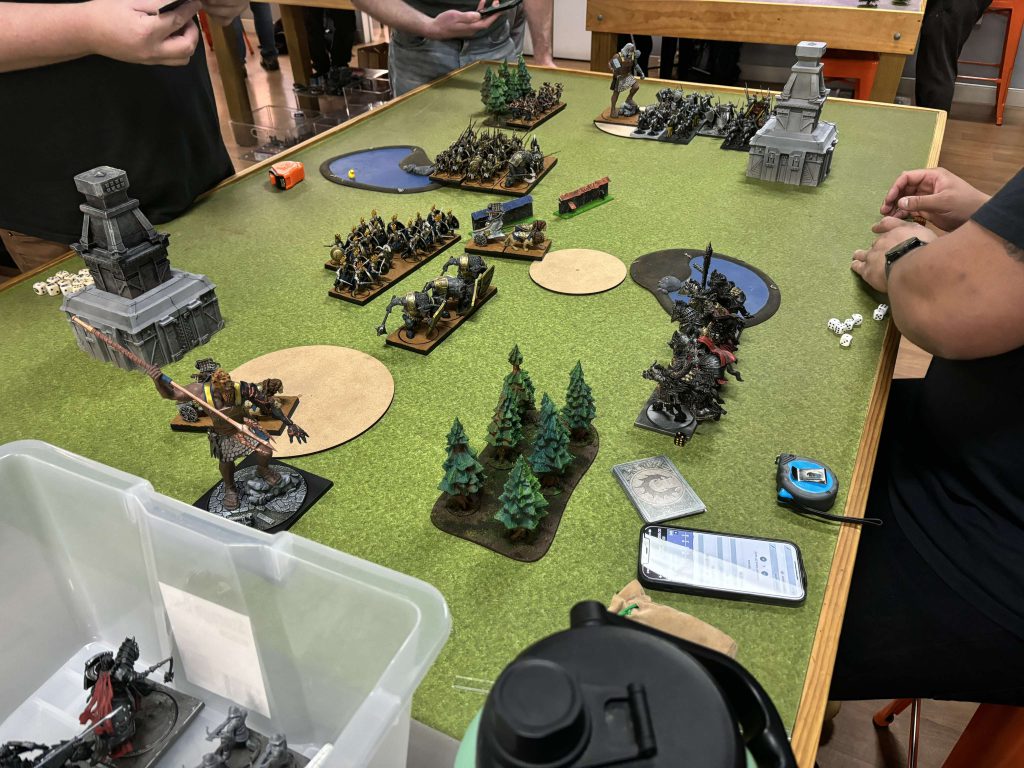
A group of men-at-arms is being charged by a group of w’ardhrun braves. After successfully rolling to hit, the Braves scored 6 hits against the men-at-arms. Men-at-arms have a D profile of 2 with the shield special rule which gives them an extra 1, making their target to roll below 3. Unfortunately they rolled poorly and 4 of the wounds go through. Two models are taken out since each of them have 2 wounds each. Finally, the the men-at-arms will need to roll 4 resolve tests comparing the results to their resolve stats of 3.
Inspire
When you take an inspire action, your next clash action will give you +1 to hit. This is the same bonus as you will get during your charge action. Typically this is what majority of your first action is going to be when you are engaged in combat. There are some nuances to this; for example if you are trying to finish off a unit that’s almost dead – do you go for clash action only, in the hopes that the dice gods give you their favor? Or do you want to spend an another action to lock in and confirm the kill? Remember, the dice gods always favor the bold players.
Combat Rally
Borrowing the concept from TLAOK, each unit in FB can be broken. You get broken by having your numbers reduced to half of what they started with at the start of the round. Now, broken itself is really really bad; we’re talking a laundry list of penalties: Cannot charge, cannot inspire, cannot seize objective and cannot gain any bonus from character and also cannot heal. Yikes.
Luckily you can perform an action to restore the morale of your fleeing units, and with a rousing speech or a wave of a banner, your unit ceases to be broken. Neat!
Combat Reform
Are the majority of your units stuck outside of the engagement range of the enemy? This unfortunate circumstance can be somewhat mitigated by this action. By taking a combat reform action, you get a march action that can be taken to get closer to the enemy. I generally would not advise taking this action since most clash actions already give you 2” movement – however there are very corner case scenario where this is useful.
Disengage
If you are a ranged unit, you are often at the mercy of a charge action. They of course have every incentive to charge you. Squishier than most and without the force to repel you back once engaged in combat. Though withdraw action would be useful in such situation – it often comes at a heavy cost.
Withdraw action in FB is the only way to get out of an engagement (or by ghosting them and leaving the country). You roll a resolve test first to determine whether it will be a clean withdrawal or a fighting withdrawal. And you better pray to the dice gods to let it be a clean withdrawal otherwise not only you take attack of opportunity by the other regiment, you also take some auto wounds depending on how many models you were engaged with.
In short, you are probably doing more work just trying to punch them back in return.
Spellcasting
Wizards, priests, undead apparition brought back from as spirits of vengeance all can cast spells. Let’s take a look at a sample spellcaster and a sample spell.

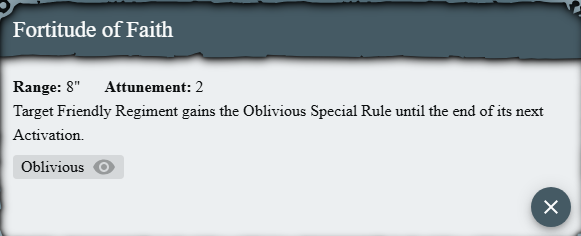
Theist Priest right here have a rule called Priest 5. This means every time the priest wants to cast a spell, they pick up 5 dice and throw them.
For example, they wanted to cast the Fortitude of Faith spell. Which has a range of 8” – meaning it can only affect a unit within 8. Attunement 2 means that it succeeds on a roll of “1” and “2”. Furthermore, if not stated otherwise – each spellcasting needs to have 2 successes in order for the incantation to be successful.
Challenge!
Borrowing the concept from TLAOK, any characters or officers can issue an action called challenge. Take an enemy character or officer within your command range and then issue a challenge. If they accept, you move your character towards engagement range of the target and then each of them perform a clash action against one another. You take defense rolls and resolve rolls like usual.
If they decline? First of all cowards. Second of all, that cowardice is represented by your character receiving a status called ‘provoked’. You see that fancy ability called command that your character have? Consider that a blank wall of text until you issue a command against the enemy.
It’s a cool concept for the leaders of your army to duel one another. Too bad that the challenge is not to the death, its simply one attack!

How to Win
The easiest way is just to wipe out your enemy’s army and table them, and there’s a lot of merit to that. But First Blood also plays in a Victory Point generation system in which each army tries to earn a certain amount of VP based on the scenario of the game, which can vary quite a bit. Some scenarios will have you fighting over three objective zones; others will have you fighting over five. Deployment zones also vary from scenario to scenario. There are currently 16 scenarios that you can pick from in a game of FB.
Quick Introduction to Each Faction
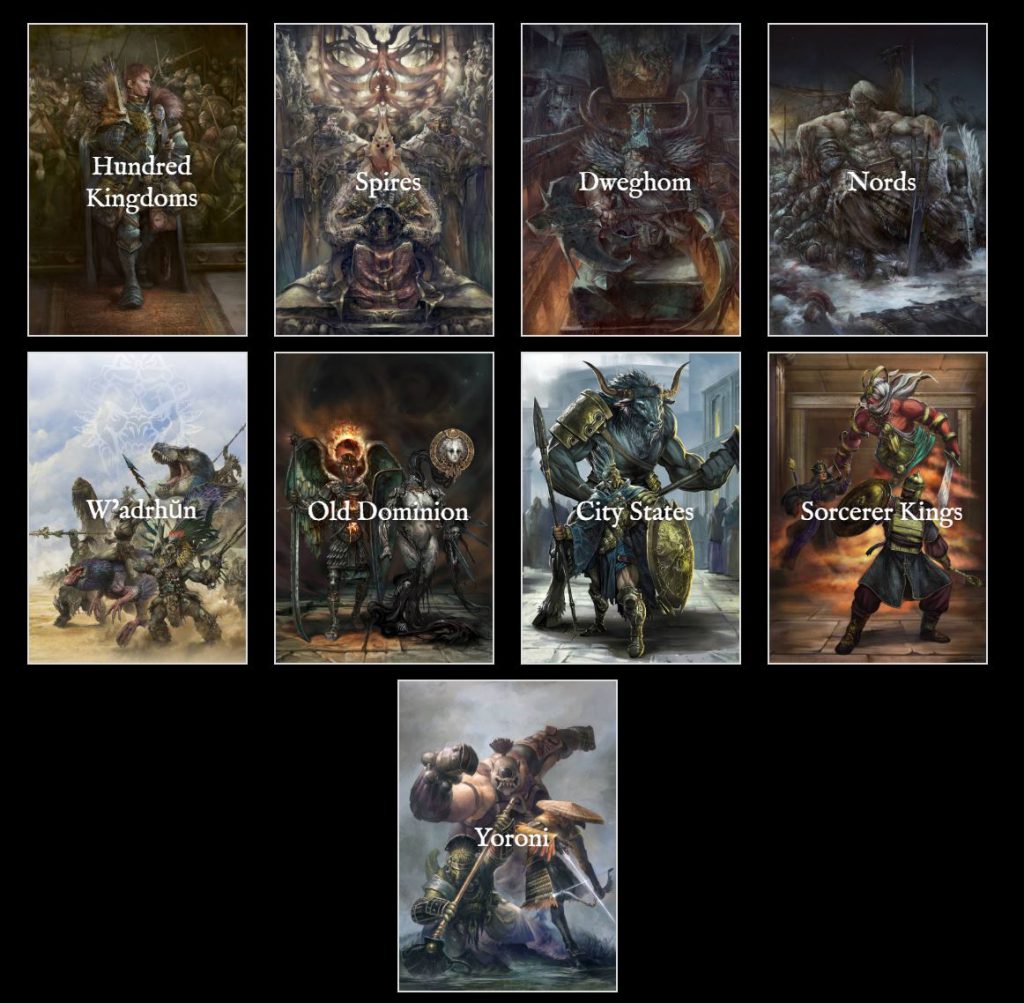
Hundred Kingdoms – The bog standard medieval human faction but with Dark Souls knights backing them up.
Spires – Bio-engineered elves from beyond the planet. Their experiments “improve” and change life on this current planet.
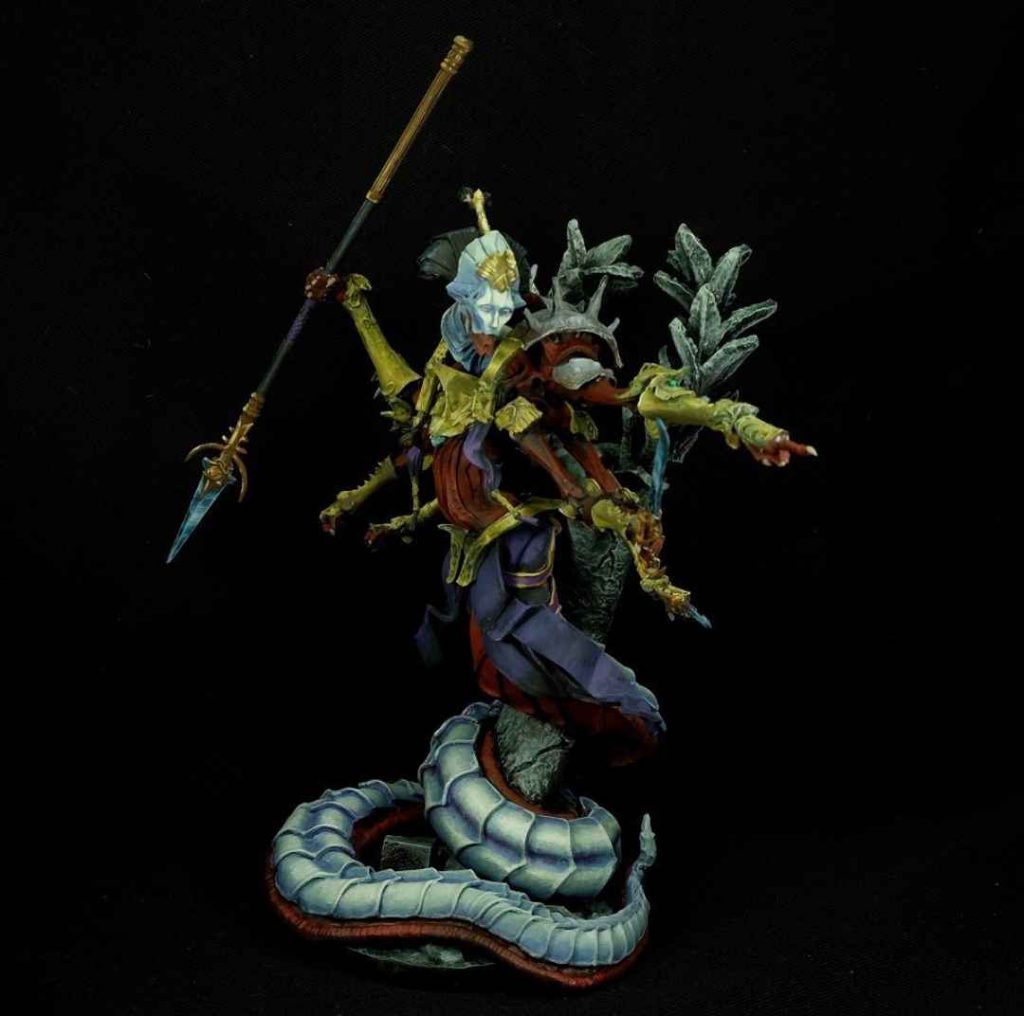
Dweghom – Angry elemental -nfused dwarves.
Nords – Superhumans living in the harsh north who believed they were chosen warriors that survived Ragnarok (turns out they were Spire experiments).
W’ardhrun – Orcs riding dinos! Also a Spire experimentation gone too well.
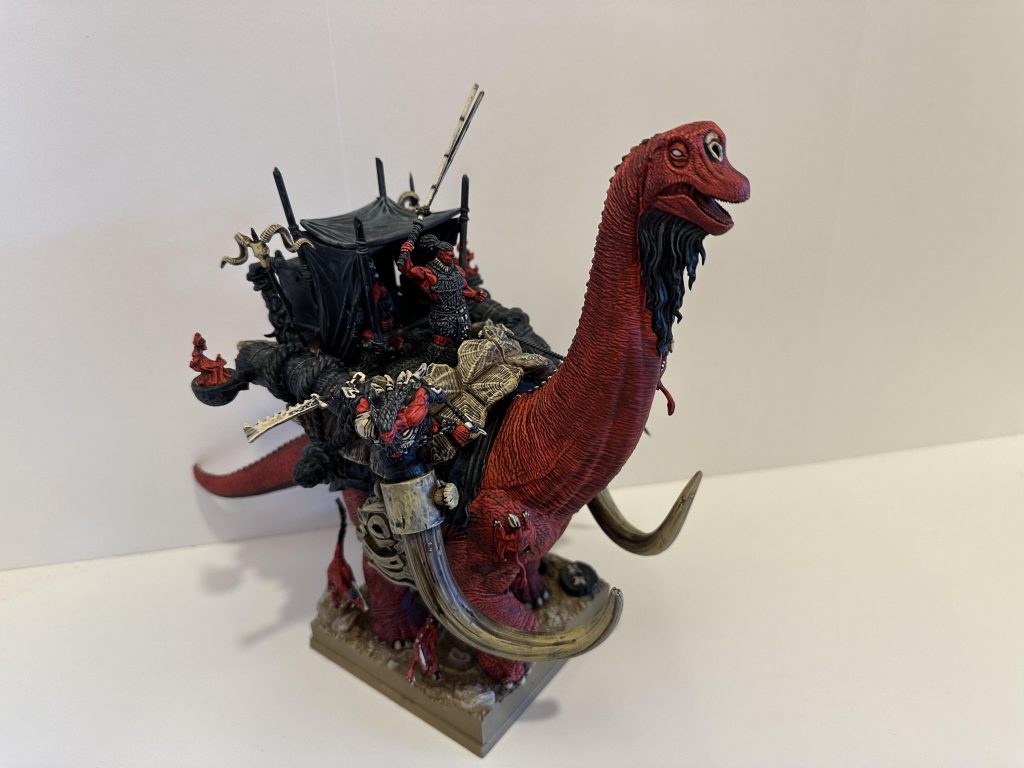
Old Dominion – Gods that turned crazy and killed their followers. Now sentenced to an eternal undeath spent wreaking havoc upon the living.
City States – Steampunk Greeks with mechanical lions!
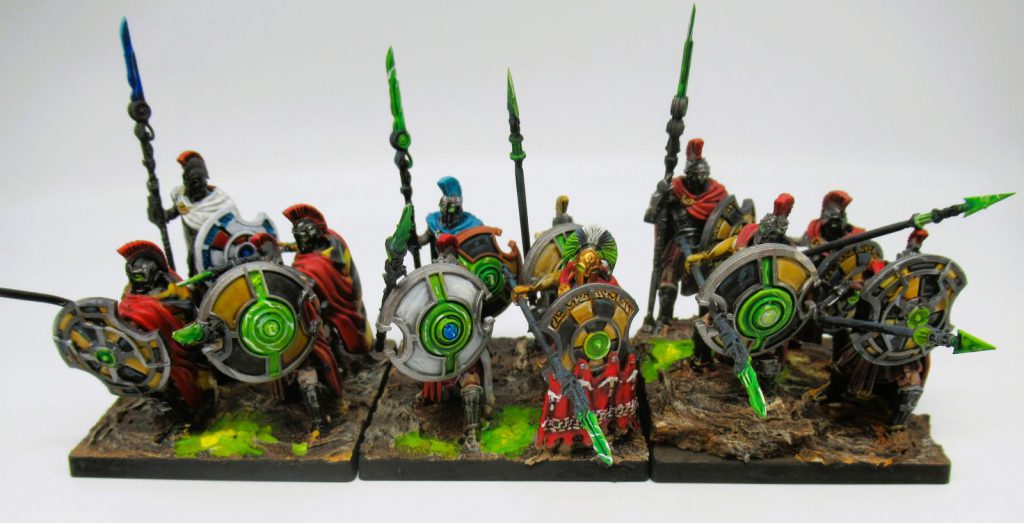
Sorcerer Kings – Elemental desert rulers with a focus on djinn.
Yoroni – Demon samurai from another plane.
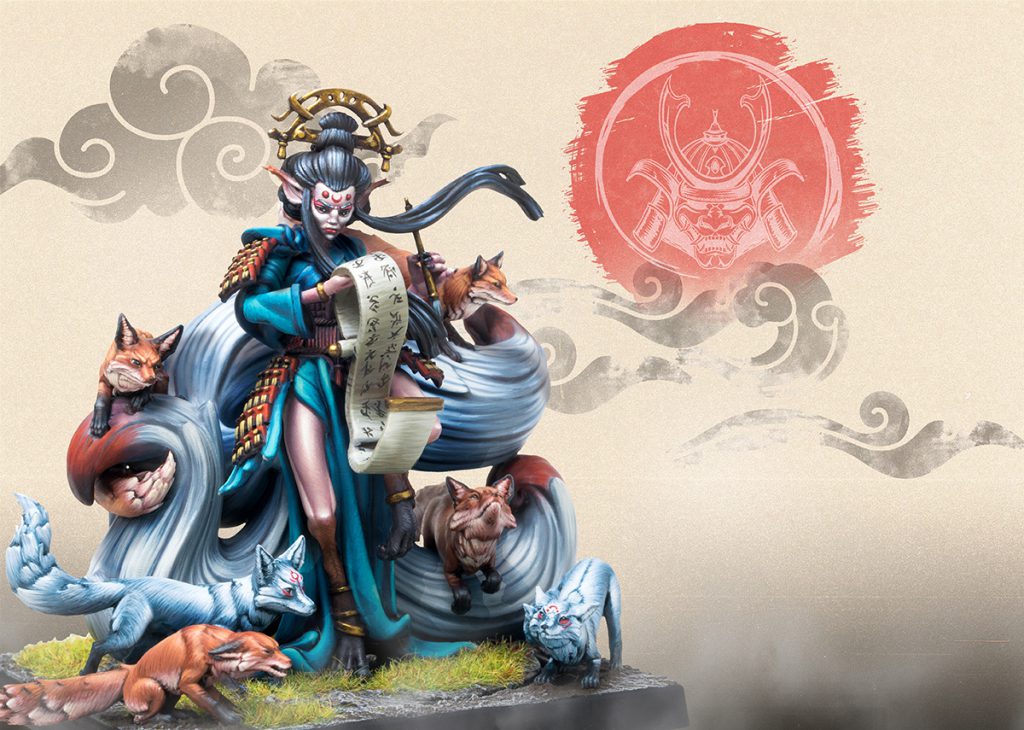
How Do You Start?
Now that you have some basic understanding on how to play this game, you can check out the set of articles that we have made for individual factions. Here are the individual First Blood factions that we’ve covered so far:
- Conquest First Blood Faction Focus: The Spires
- Conquest First Blood Faction Focus: The City States
- Conquest First Blood Faction Focus: W’adrhŭn
- Conquest First Blood Faction Focus: Hundred Kingdoms
- Conquest First Blood Faction Focus: Old Dominion
- Conquest First Blood Faction Focus: Yoroni
But if you wanna jump in immediately, great! The best place is to get them is through Para Bellum’s site. It’s the perfect ‘sampler’ box, but with a few issues.
The First Blood Sorcerer Kings Warband (and every other faction) is currently going on sale for 39.99. There is a very good reason for the sale since Parabellum looks to be phasing out this old warband starter in lieu of their new ‘cohort’ box which will feature a ready to play 1,000 points list FB army.
This warband is considered a taster of the experience, and coincidentally, it’s literally half of a full FB army. let’s take a look at the content:
8 Ghols (infantry)
8 Rajakur (infantry)
1 Efreet Sword Dancer (brute)
1 Raj (character)
And all the bases and command cards that comes with it.
The above package will get you 480 points which is a pretty good deal considering that you just need to buy a second box and you get yourself a functional 1,000 points list army (plus some upgrade to your character).
So you will end up with a list like the following:
=== First Blood ===
Sorcerer King – Two Starters [990/1000]
Sorcerer Kings
* Raj [30]: Karana, Court of Fire
* Ghols (8) [130]:
* Rajakur (8) [210]:
* Efreet Sword Dancers (1) [140]:
* Ghols (8) [130]:
* Rajakur (8) [210]:
* Efreet Sword Dancers (1) [140]:
For under 80 bucks you get 35 models and the list itself is not shabby. Raj is an offensive spellcaster that can trade its ‘wizard’ level for extra attacks. Ghols are cheap with a lot of attacks and Rajakur are quite sturdy for their cost. The sword dancers can potentially spike to them having a ‘critical’ on a roll of 1 – meaning that attack roll of 1 counts as two hits.
The issue with this product of course its that it does not come with the tools needed to play the game. Namely dice, rulers or even some terrain you need to get started. While I am sure in your LGS will have those in droves, it’s more for players who plays at their home and have limited access to the stockpile of terrains that LGS has.
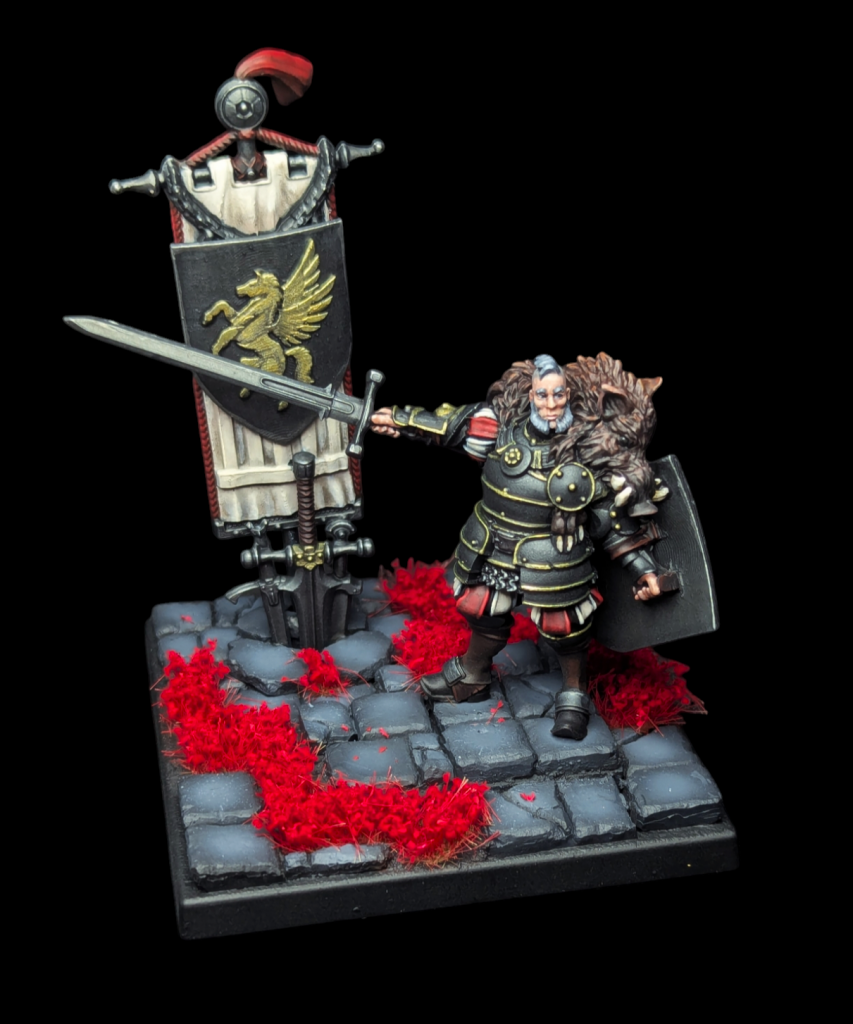
Conclusion
Whether you are a TLAOK player trying to get more mileage out of your models or a player that wants to dip their toe in the world of Conquest without spending hundreds of dollars – First Blood has a lot to offer you.
Definitely faction choice will be the most important factor of your journey and that one will require more reading and understandings. Certainly if nothing else, you should enjoy playing the fantasy trope that you like.
Until next time!
As always if you want to get 10% off and support Goonhammer you can make your Conquest purchase by clicking here for US/Canada or here for EU/rest of world. You’ll also need to enter code “goonhammer” at checkout.
Have any questions or feedback? Drop us a note in the comments below or email us at contact@goonhammer.com. Want articles like this linked in your inbox every Monday morning? Sign up for our newsletter. And don’t forget that you can support us on Patreon for backer rewards like early video content, Administratum access, an ad-free experience on our website and more.
